
Latest News
- Hyundai E&C Accelerates Global Nuclear Expansion into the U.S. Nuclear Market
- Hyundai E&C Shifts into High Gear to Enter Nordic Large-Scale Nuclear Market
- Hyundai E&C Strengthens Korea-Japan Cooperation in Energy Transition and New Growth Businesses
- Hyundai E&C Signals Green Light for Large-Scale Nuclear Power Plant Business in Europe
- Hyundai E&C Unveils Energy-driven Growth Strategy “H-Road”
From Eco-friendly to Advanced Future Technology: Hyundai E&C`s Values Behind Hospital Construction
What kind of space comes to mind when you think of a hospital?
The cold and bleak image of hospitals is changing. From eco-friendly hospitals that blend in with nature, healing spaces for the holistic healing of body and mind, to creating an environment for comfortable treatment with advanced healthcare facilities… Hyundai E&C is at the heart of such “hospital”, a companion for healthy life and healing. Here is a glimpse into the story behind the hospitals built by Hyundai E&C, a leader in the 21st century hospital construction.
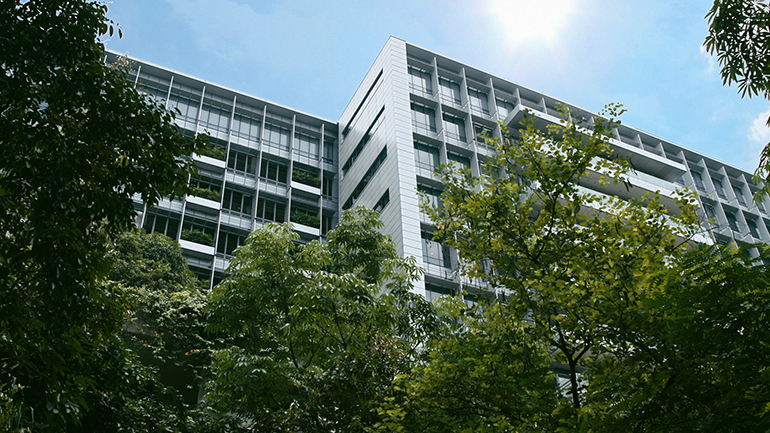
[Khoo Teck Puat Hospital]
Hospitals are the first place we turn to when we're sick. Equipped with the essential facilities to treat patients, hospitals are one of the major infrastructures that are indispensable. In the early 19th century, hospitals were a far cry from what they are today. They were more about housing patients who had nowhere else to go than treating them, and in Europe, convents were often used to house patients. It was “Nightingale”, the "angel in white," who rebelled against such hospital environment, arguing that changing the layout of beds or installing windows would help patients recover. Indeed, after making such changes to the space, patients began to noticeably improve. With this natural shift in perception, the image of hospitals also greatly evolved. Hospitals have been transformed into places that not only maximize its fundamental role of treating patients, but also offer a sense of psychological stability to visitors. Hyundai E&C has been a leader in hospital construction since 1971, starting with the U.S. Army 121st Evacuation Hospital in Yongsan, followed by St. Mary's Hospital in Seoul, Asan Medical Center in Seoul, Kutek Puat Hospital in Singapore, and Hamad Medical City in Qatar. As such, Hyundai E&C has established itself as a leader in hospital construction undertaking more than 46 projects in Korea and abroad. Now, let's take a look at some of Hyundai E&C's hospital projects so far.
Renowned as Iraq's leading hospital
Medical Complex City, Iraq (1986)

Awarded in July 1980, the Iraq Medical City Complex project was not only Hyundai E&C's first hospital built abroad, but also a significant project in terms of developing a large-scale medical complex. At the time, Iraq was in the midst of implementing the so-called "2005 Project" to build a state-of-the-art medical complex in downtown Baghdad by 2005 as part of its economic development plan. Hyundai E&C won the second phase of the project, worth $327 million. At the time, this value was considered one of the top 10 contracts in the Middle East and generated a lot of buzz. Hyundai E&C built a total of nine wards, including a 1,000-bed, 20-story surgical ward, pediatric ward, general ward, hearing disability ward, and auxiliary ward. The Medical Complex City continues to maintain its prestige as one of the top hospitals in Iraq, serving not only the Iraqi people but also working as a critical hospital for allied forces engaged in the Iraq War.
Human-Scale Design Adds Intimacy
Asan Medical Center, Seoul (1989)
 770.jpg)
[Source: Asan Medical Center, Seoul]
Established in 1977 by founding chairman Chung Ju-yung, the Asan Foundation began building general hospitals equipped with top healthcare professionals and modern facilities in medically underserved areas with the philosophy of "helping the most underprivileged in our society." Starting with Jeong-eup in 1978, Hyundai E&C built Boseong Asan Hospital (1978), Boryeong Asan Hospital (1979), Yeongdeok Asan Hospital (1979), and Seoul Asan Medical Center(1989), leading the way in the area of healthcare infrastructure. Among them, the Seoul Asan Medical Center, located in Songpa-gu, Seoul, is characterized by a design that focuses on generous green spaces and human scale* allowing everyone including patients and visitors to feel comfortable in these healthcare spaces. The Asan Medical Center in Seoul became more convenient by introducing a medical information system that computerizes the entire process of appointments, treatment, hospitalization, and discharge, which was quite new at the time. Hyundai E&C built the west wing of Seoul Asan Medical Center, followed by the east wing (1995) and the new wing (2008), helping to create the nation's largest hospital, which has played a pivotal role in the development of Korean medicine.
*Human scale: It is about deciding all elements of a space according to the size of human body, and refers to the sense of size that an object or space brings to a person
The Comfort of a Wide-open Atrium
Seoul National University Hospital, Bundang (2003)
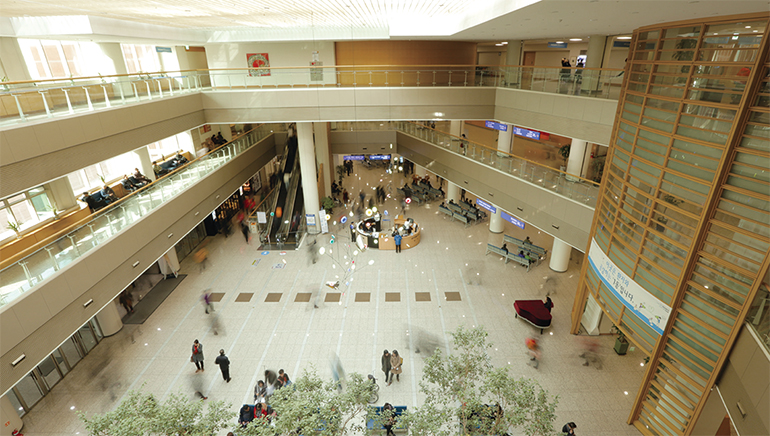
Hyundai E&C was tasked with the new construction (1994) and refurbishment of Seoul National University Hospital, located in Daehak-ro, Jongno-gu, Seoul, Korea. The trust built during that time led to the construction of Seoul National University Hospital in Bundang in 2003. Established in the 1990s to provide medical care for local residents in the new city of Bundang, Seoul National University Bundang Hospital was initially intended to open as a hospital specializing in geriatrics. It was later transformed into a general hospital with advanced IT & healthcare facilities and is now a major national hospital with more than 800 beds and an average of 3,000 patients visiting daily. As the first digital hospital without paper, charts, or film, it has established a medical IT system including a medical imaging transfer system and electronic medical records, and was the first hospital in Korea to receive Level 7 certification, the highest level of informatization for medical institutions, from the American Medical Informatics Association. The atrium in the hospital's central lobby has become the symbol of Seoul National University Bundang Hospital and a cultural space where performances and concerts are held. The space, created by Hyundai E&C taking into account natural light, is centered on the atrium and has separate waiting areas for each department for outpatients, improving patient convenience by splitting the flow of traffic.
Green Design Enhances “Natural Healing”
Kutek Puat Hospital, Singapore (2010)

Yishun, 20 kilometers from Singapore's city center. Unlike the city center, which is densely packed with skyscrapers, Kutek Puat Hospital is surrounded by lakes and forests, making people feel like at home. Hyundai E&C, which was awarded the project to build this hospital in 2008, incorporated various eco-friendly elements into the design, materials. The most notable is the use of solar energy by bringing natural light and reflected light into the building. Also the company recycled air by diverting cold air from the operating room to the courtyard, and incorporated green technologies by installing heat pumps to utilize waste heat. These efforts have earned the building a gold award at the Universal Design Awards, hosted by the Singapore's Building and Construction Authority (BCA) and a platinum award at the BCA's Green Mark, the world's top three green certification programs.
Meanwhile, while Kutek Puat Hospital, Singapore's third-largest hospital, is responsible for providing healthcare services to more than 1 million people in the northern district of Yishun, Changi Hospital is located in the eastern part of Singapore. Built by Hyundai E&C in 1996, Changi Hospital is still considered one of the world's leading specialized hospitals for neuro and orthopedic surgery.
A Hotel-inspired Hospital Delivering Luxury and Comfort
Hamad Medical City, Qatar (2016)
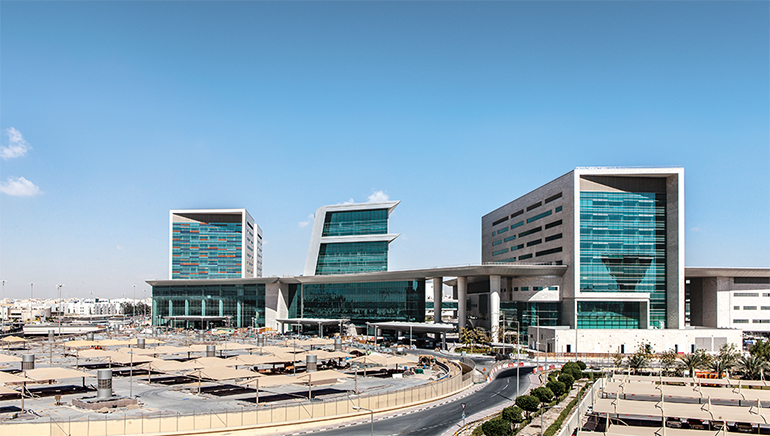
Hyundai E&C is contributing to the improvement of healthcare services by building advanced healthcare facilities in Qatar, a country with poor medical facilities. Among them, Hamad Medical City is a large-scale medical complex with a gross floor area of 178,000m2. It was a challenging project to convert a building that was used for the 2006 Doha Asian Games into a healthcare facility, installing the latest medical equipment and creating a luxurious hotel-like interior. Hyundai E&C was able to win a number of hospital projects in Qatar thanks to its advanced engineering and technological capabilities, setting itself apart from other simple construction contractors.
Some examples include Al Maha Center for Children and Young Adults(2021), which focused on design and interiors to help improve the mental and physical well-being of children and adolescents, and the renovation of the Women's Hospital to transform it into a surgical center(2021). In addition, Hamad bin Khalifa Medical City SNP (2022), a specialized nursing hospital, showed the evolution of healthcare facility architecture by adding more amenities for mobility such as lifts and bridges inside the building to improve patient and healthcare professionals’ convenience.
A Healing Space at the Foothills of Mount Bukhansan
Eunpyeong St. Mary's Hospital (2019)

Hyundai E&C has been working with the Catholic University Hospital on four projects: Seoul St. Mary's Hospital, St. Paul's Hospital, Bucheon St. Mary's Hospital, and Eunpyeong St. Mary's Hospital. Among them, Eunpyeong St. Mary's Hospital, located in Eunpyeong-gu, Seoul, was highly anticipated as the largest hospital in the northwestern region of Seoul before its construction. With more than 800 beds, it is comparable to Seoul St. Mary's Hospital, the largest single-building hospital in Korea. The hospital takes advantage of its location at the foothills of Bukhansan Mountain and makes use of the surrounding greenery, creating some 2,644m2 “Healing Forest” on the second floor of the building, providing physical and mental comfort for patients and their families amidst the beautiful nature. The space embodies Eunpyeong St. Mary's Hospital's motto of healing both the mind and body of patients. Patient-centered systems have been applied throughout the hospital. Temperature-controlled LED lighting for natural light, a green waiting area, barrier-free facilities, and short and easy pathways for patient convenience are just a few of the thoughtfully laid-out features. In addition, as a smart hospital with the largest medical network in Korea, it has implemented cutting-edge medical environments based on voice recognition systems, centralized reading systems, and artificial intelligence rounding robots. Eunpyeong St. Mary's Hospital, which is committed to eco-friendliness, was the first university hospital in Korea to obtain the level one energy-efficient building certification and green building certification.
Future Hospital to Lead the Medical Industry 4.0
Convergence Medical Center, Korea University Anam Hospital (Scheduled for completion in 2023)
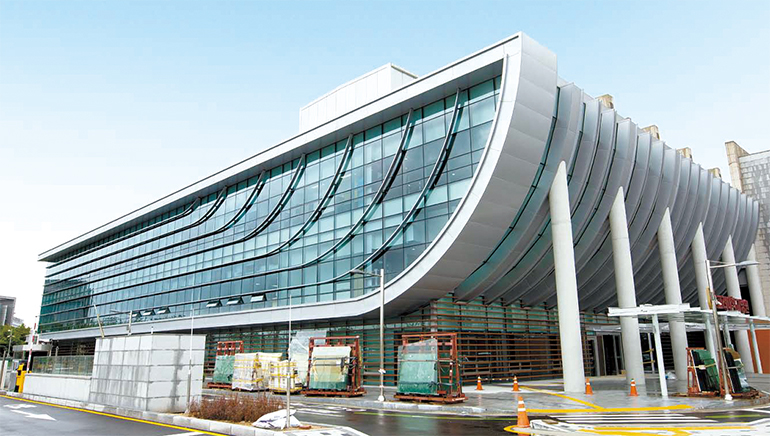
More than 30 years ago, Hyundai E&C established a relationship with Korea University Medical Center when it built the Korea University Anam Hospital. In 2017, the two sides met again to construct an advanced convergence medical center, which was the long-standing aspiration of the Korea University Anam Hospital. The Convergence Medical Center is a healthcare facility that is essential to lead the upcoming 4th industrial revolution in healthcare, which includes an R&D center that integrates medical treatment and research capabilities and provides personalized precision medical services. This project was different from other new construction projects because it required adding a new building in front of the main building and securing a connection to the main building. Hyundai E&C was particularly focused on minimizing the inconvenience to patients and visitors. It worked to ensure safe construction by exploring the safest blasting method to remove the rock garden on the site and applying construction methods to minimize noise and dust. In 2020, Hyundai E&C successfully completed the phase 1-1 of the project, and recognized for its achievements, successfully won the follow-up phase 1-2 project as well. Currently, the phase 1-2 project is scheduled to be completed in the first half of this year. In the future, the Convergence Medical Center will become an advanced medical facility, where different ICT-based systems including Internet of Things (IoT) and various medical-grade 4th Industrial Revolution technologies will come to life.
Envisioning a Hospital without Walls
United Christian Hospital, Hong Kong (scheduled for completion in 2025)
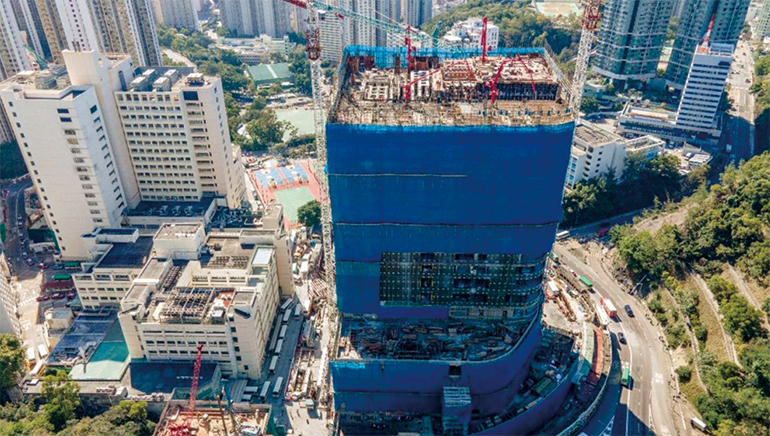
Founded in 1973, United Christian Hospital is the only hospital in the Kwun Tong district of Hong Kong's Kowloon Peninsula and one of the largest hospitals in Hong Kong. In order to fulfill the hospital's motto, "Hospital without Walls," and to provide advanced healthcare services, the hospital decided to demolish and expand its existing aging facilities. The total project amounted to approximately KRW 1.4 trillion, of which Hyundai E&C won a contract worth KRW 42 billion. Hyundai E&C was able to re-enter Hong Kong after 16 years by presenting differentiated designs and construction methods that meet the needs of a future advanced hospital and establishing strategic partnerships with local companies.
United Christian Hospital distinguishes itself with a twin-tower structure rather than a monolithic building. Hyundai E&C connected the two buildings with a skybridge to create a visual impact, as well as convenience and safety in moving between the buildings. When the hospital is completed in 2025, it is expected to become one of the top hospitals in Hong Kong with its upgraded healthcare services, including an oncology center that will provide one-stop care for all cancer patients and advanced healthcare facilities.

